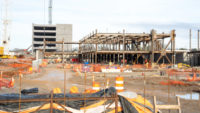Economy
Labor, Materials Prices Drive Construction Costs Higher: IHS Markit Index

Photo by Michael Maddox/U.S. Army Corps of Engineers Louisville District
Construction and engineering costs continued to rise in August as materials and labor prices also continued to grow, according to an indicator tracking wage and material inflation for construction and related sectors.
The IHS Markit PEG Engineering and Construction Cost Index remained elevated in mid-August, dropping slightly to 68.6 from 68.9 in July. A reading of 50 represents the breakeven point. Higher readings indicate rising prices.
Subcontractor labor cost increases remained particularly high, with an index reading of 85.2, up from 81.8 in July.
Materials and equipment costs also continued to rise, with a reading of 61.5. Within that, sub-indexes show variation between different goods. Pumps and compressors rose 21.4 points to a reading of 75. Meanwhile, carbon steel pipe and alloy steel pipe both dropped to 45.5, which analysts from IHS Markit parent S&P Global Market Intelligence say is the first decrease in their prices after 21 months of growth.
“Prices for some pipe products have eased as lower raw material costs are passed through, however, there is wide variation by product,” Amanda Eglinton, economics director of pricing and purchasing at S&P Global Market Intelligence, said in a statement. “Prices for standard, mechanical and HSS have started to decline, though energy pipe and tube and specialty and high nickel alloy grades remain in short supply with prices continuing to move higher through the third quarter.”
Respondents to IHS Markit’s survey also indicated they expect prices to continue to rise over the next six months. They reported shortages of materials including electrical steel, eclectic components and cement, the data firm says.
The IHS Markit PEG Engineering and Construction Cost Index is based on surveys of members of the “Procurement Executive Group” asking whether prices for individual materials, equipment and regional subcontractor rates were higher, lower or the same compared to the previous month, and what are their six-month expectations for those prices.
Responses are weighted for every $2 billion of the firms’ North America spending.




